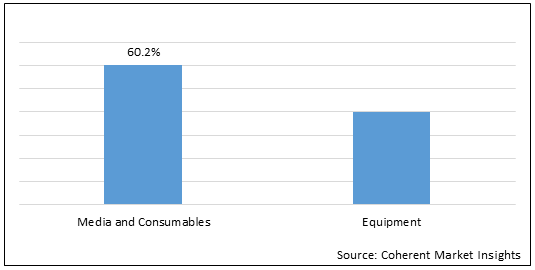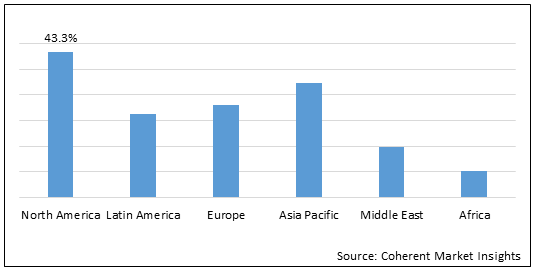A tissue bank is an establishment that collects and recovers human cadaver tissue for the purposes of medical research, education and allograft transplantation. A tissue bank may also refer to a location where biomedical tissue is stored under cryogenic conditions and is generally used in a more clinical sense. A tissue bank is an organization that provides donor screening, recovery, processing, storage, and/or distribution of allograft tissue. Currently, there are three levels of tissue bank regulation: the U.S. Food and Drug Administration (FDA), the American Association of Tissue Banks (AATB), and the state governments.
The global tissue banking market is estimated to be valued at US$ 1.63 billion in 2022 and is expected to exhibit a CAGR of 10.8% during the forecast period (2022-2030).
Figure 1. Global Tissue Banking Market Share (%), by Product, 2022

To learn more about this report, Request sample copy
Increasing government initiatives and rising demand for transplantation are expected to drive growth of the global tissue banking market
According to University of Texas Southwestern Medical Center 2018 report, about 450,000 Americans underwent tissue transplants to improve or save their lives and nearly 45,000 corneal transplants were done to restore sight. As per the same source, over 300,000 bone grafts were expected to be used in the treatment of degenerative bone diseases, malignancies, and traumatic injuries. Demand for other tissue such as heart valves, and venous and connective grafts also have increased. Heart valves are frequently utilized in pediatric surgeries, even in infants. According to Ovarian Cancer Canada (OCC), 2017, the OCC Tissue Banking Network collects samples from 800 to 1,000 women with ovarian cancer each year.
Tissue Banking Market Report Coverage
| Report Coverage | Details | ||
|---|---|---|---|
| Base Year: | 2021 | Market Size in 2022: | US$ 1.63 Bn |
| Historical Data for: | 2017 to 2020 | Forecast Period: | 2022 to 2030 |
| Forecast Period 2022 to 2030 CAGR: | 10.8% | 2030 Value Projection: | US$ 3.70 Bn |
| Geographies covered: |
|
||
| Segments covered: |
|
||
| Companies covered: |
AbD Serotec (a Bio-Rad company), AMS Biotechnology Limited, BioLife Solutions, Inc., Beckman Coulter, Inc., BioCision LLC, BioStorage Technologies, Inc., Custom BioGenic Systems, Eppendorf AG, EMD Millipore Corporation, Fisher BioServices, Inc., Genzyme Corporation, Hamilton Company, Merck KGaA, PHC Corporation, and Teva Pharmaceutical Industries Ltd |
||
| Growth Drivers: |
|
||
| Restraints & Challenges: |
|
||
Uncover macros and micros vetted on 75+ parameters: Get instant access to report
Figure 2. Global Tissue Banking Market Share (%), by Region, 2022

To learn more about this report, Request sample copy
Increasing use of advanced methodology for tissue banking is expected to drive the market growth during the forecast period.
Increasing use of advanced methodology for tissue banking is expected to drive the market growth during the forecast period. For instance, in August 2022, Carnegie Mellon University, Biothermal Technology Laboratory, introduced a new model approach for isochoric preservation known as cryopreservation to preserve organ and tissue. Cryopreserving tissues and organs without damaging them requires a delicate handling through the principles of thermodynamics. Research on cryopreservation focuses on preserving whole organs for long-term storage and viability, the success of which can be a major medical advancement. Currently, organs like the heart, liver, and pancreas can survive for a few hours outside the body. Cryopreservation has the potential to extend this time limit to several days or even longer. Cryopreservation has only been successful on very small tissue, such as embryos and stem cells.
Global Tissue Banking Market– Impact of Coronavirus (COVID-19) Pandemic
Since the COVID-19 virus outbreak in December 2019, the disease has spread to over 100 countries across the globe and the World Health Organization had declared it a public health emergency on January 30, 2020.
COVID-19 can affect the economy in three main ways: by directly affecting production and demand of drugs, by creating disruptions in distribution channels, and through its financial impact on firms and financial markets. Due to nationwide lockdowns, several countries, such as China, India, Saudi Arabia, U.A.E., Egypt, and others, are facing problems with regards to the transportation of drugs from one place to another.
However, the COVID-19 pandemic had a negative impact on the global tissue banking market, owing to the disruption in health care services during COVID-19 pandemic. For instance, in July 2020, according to the National Center for Biotechnology Information, hospitals and health facilities overwhelmed with COVID-19 patients are making it difficult for other patients with acute or chronic ailments to access standard care. Spanish government made strict confinement measures accompanied by a range of social distancing measures, including closure of schools, universities, libraries, centers for older people, and sporting venues, and even restricting all movement that have been in place since March 14 2020 (royal decree 463/2020 to declare a 15-day national emergency). In conclusion, the data study suggest that the impact of coronavirus in Spain has affected dramatically tissue donation but with a moderate effect on stored tissues such as bone, valves or skin.
Global Tissue Banking Market: Key Developments
In January 2020, LifeCell International, India's premier human cells tissues and genetics services provider received accreditation from the American Association of Tissue Banks (AATB) for its birth tissue products. This accreditation positions LifeCell as the first & only company not only in India but also outside the U.S. to receive this accreditation. This accreditation certifies the entire process of consent, birth tissue acquisition, processing, release, storage and distribution. Birth tissue products include the placenta, umbilical cord, and amniotic fluid. Of these the most widely used product is the placental amniotic membrane, which is used as a biological bandage for management of wounds in a variety of specialties such as podiatry, ophthalmology, burns, gynecology, general and plastic surgery. LifeCell will soon launch the product in India under the brand "Amchoplast" from its manufacturing facility in Chennai, India.
Global Tissue Banking Market: Restraint
The major factors that hinder growth of the global tissue banking market include the tissue banking organization is complex system and need for high technical expertise and skilled personnel for proper functioning in a dedicated facility. Minor errors in the established protocol can lead to loss of expensive tissues, harm to recipients as well as can increase risk of transmission of deadly diseases and tumors. Insufficiency and scarcity in tissue availability is also a major factor hindering growth of the tissue banking market. According to Organ Procurement and Transplantation Network (OPTN), in 2017, over 119,000 men, women, and children await lifesaving organ transplants in the U.S., and over 8,000 people die each year due to lack of required organs.
Key Players
Major players operating in the global tissue banking market include AbD Serotec (a Bio-Rad company), AMS Biotechnology Limited, BioLife Solutions, Inc., Beckman Coulter, Inc., BioCision LLC, BioStorage Technologies, Inc., Custom BioGenic Systems, Eppendorf AG, EMD Millipore Corporation, Fisher BioServices, Inc., Genzyme Corporation, Hamilton Company, Merck KGaA, PHC Corporation, and Teva Pharmaceutical Industries Ltd.
Share
Share
Missing comfort of reading report in your local language? Find your preferred language :
Transform your Strategy with Exclusive Trending Reports :
Frequently Asked Questions
Select a License Type
Credibility and Certifications

860519526

9001:2015
27001:2022


Joining thousands of companies around the world committed to making the Excellent Business Solutions.
View All Our Clients
US Reciprocal Tax Impact Analysis On Tissue Banking Market
Stay updated on tariff changes with expert insights and timely information